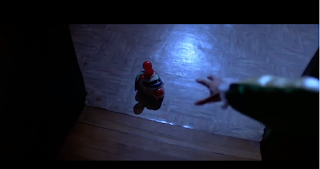Contrast
In the video, we utilized contrast to juxtapose Ethan's happy, outgoing personality, with Garrett's sad and downtrodden personality. This is mainly shown through the use of music. When Ethan is on screen, we are greeted with upbeat stock music to show that Ethan is bubbly and personable. This is further emphasized by his social behaviour when walking down the hallway. On the other hand, when Garrett is on screen all we can hear is a melancholic guitar riff. This illustrates that Garrett is sad and walled off from people, which is reinforced by his reaction towards people in the hallway.In short, the scene is built around the juxtaposition of two opposite personalities, and is expressed through the music and the characters' behaviour.
Parallelism
For parallelism, we chose to film two nearly identical scenes for each character. The scenes, both inter-cut with each other, show the character's walking down the hallway, opening their lockers, and then beginning to walk down the hallway past their friends. The parallelism between the two characters' actions is meant to emphasize the contrast between them by making the scene easy to understand together, almost as if the independent variables of the scenes are the characters, while everything else is kept the same.
Symbolism
In the film, we utilized symbolism to accentuate Garrett's isolation. Unlike Ethan, Garrett is listening to his music through his headphones. This further establishes how Garrett is blocked off from his peers, and cannot hear them trying to say hello and cheer him up. The headphones symbolize how he is walled off from happiness.
Simultaneity
To demonstrate simultaneity, we synced up the scenes of Ethan and Garrett walking to be taking place at the same time. To achieve this, we filmed two nearly identical scenes for each character to display their own personalities. Then, we cut them together in the editing process to make it seem like they were concurrent, with the scene ending in a collision between the two characters.
Leit Motif
We decided to go heavy handed with the use of leit motif in the film, choosing to signify the character's presence with music. Even if the character's faces are not being shown, we know who the shot will focus on in relation to the music that is playing. Ethan is signified by upbeat stock music, while Garrett is signified by melancholic guitar music.
Once again, these are used as motifs to let us know who the shot is focused on.











